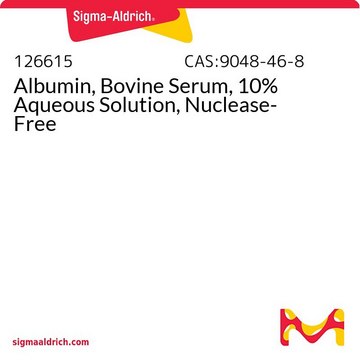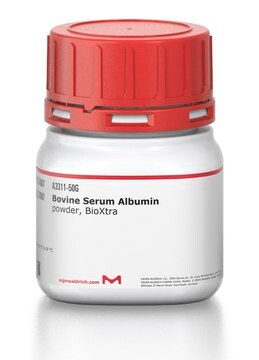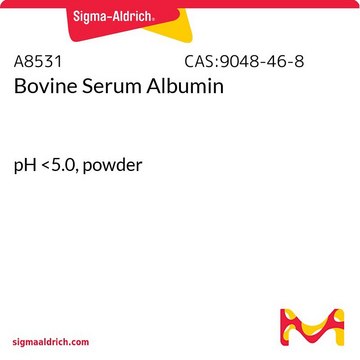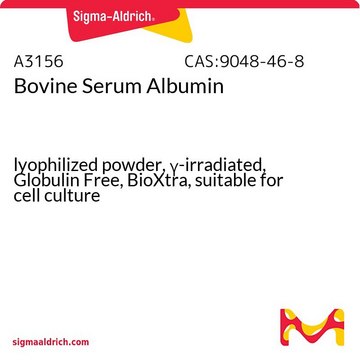A0281
Bovine Serum Albumin
lyophilized powder, essentially fatty acid free and essentially globulin free, ≥99% (agarose gel electrophoresis)
Synonym(s):
Albumin bovine serum, BSA, Bovine albumin
About This Item
Recommended Products
biological source
bovine
Quality Level
Assay
≥99% (agarose gel electrophoresis)
form
lyophilized powder
mol wt
~66 kDa
purified by
cold ethanol and heatshock fractionation
packaging
poly bottle of
origin
USA origin
free fatty acid content
≤0.01%
technique(s)
enzyme immunoassay: suitable
impurities
essentially globulin free
≤0.01% Fatty acids
pH
7
solubility
water: soluble (40 mg/ml)
UniProt accession no.
storage temp.
2-8°C
Gene Information
bovine ... ALB(280717)
Looking for similar products? Visit Product Comparison Guide
General description
This BSA product is specifically tested for the following properties:
- very low FA content / essentially fatty acid free
- low globulin content / essentially globulin free
Application
Biochem/physiol Actions
Features and Benefits
- Essentially fatty acid-free
- Essentially globulin-free
Preparation Note
Storage Class Code
11 - Combustible Solids
WGK
WGK 3
Flash Point(F)
Not applicable
Flash Point(C)
Not applicable
Personal Protective Equipment
Regulatory Listings
Regulatory Listings are mainly provided for chemical products. Only limited information can be provided here for non-chemical products. No entry means none of the components are listed. It is the user’s obligation to ensure the safe and legal use of the product.
JAN Code
A0281-BULK:
A0281-100G:
A0281-EW:
A0281-100MG:
A0281-10G:
A0281-250MG:
A0281-VAR:
A0281-1G:
A0281-5G:
Certificates of Analysis (COA)
Search for Certificates of Analysis (COA) by entering the products Lot/Batch Number. Lot and Batch Numbers can be found on a product’s label following the words ‘Lot’ or ‘Batch’.
Already Own This Product?
Find documentation for the products that you have recently purchased in the Document Library.
Customers Also Viewed
Our team of scientists has experience in all areas of research including Life Science, Material Science, Chemical Synthesis, Chromatography, Analytical and many others.
Contact Technical Service




